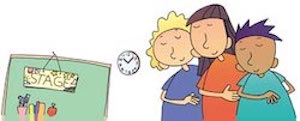
The first weeks of school feel like a whirlwind. Students enter our classrooms full of wonder but also worry: Am I smart enough? Will people accept me? Do I belong here?
You can ease their worries by building a sense of belonging. If students are to learn with confidence, trust their voices and ideas, and build positive relationships, they need to feel that they belong.
Below we’ve outlined some of our favorite activities for helping students feel welcome and wanted.
Building Belonging in Elementary Grades
Try these activities with your young learners.
Better Together Blocks
Use this block-stacking activity from In Focus to demonstrate that each person is a valuable part of your classroom. Students work in teams to build a sturdy block tower that represents the entire class. Take away a bottom block to show what happens when someone is left out of the classroom community.
Classroom Scavenger Hunt
Challenge students to get to know the lay of the land in your classroom. Create a scavenger hunt that includes a list of important places (reading corner, sanitizing station) and resources (books, art supplies, posters). Get creative by placing clues or riddles in certain spots. Divide students into small teams and set them off on the hunt!
"This or That" Questions
Use "This or That" questions to build common ground among students. Designate two spaces in your classroom to represent two different answers. Ask a “This or That” question, pointing to one space for one option and the other space for the other option. Have students move to the space that represents their answer. Then repeat the process with more “This or That” questions.
Webs of Connection
Form a circle with your whole class or in small groups. Hold the loose end of some rug yarn and pass the skein to a student across the circle. The student will hold on to the piece of yarn and pass the skein to another student until each person is holding on to the long piece of yarn. (To enrich the activity, ask students to share something about themselves when they receive the yarn—a hobby, a favorite movie, a worry.) Point out that each person is needed to create the web. Use this point to discuss how each person is an important and valuable part of the classroom.

Building Belonging in Middle Grades
Try these activities with preteens or early teens.
Alien Greetings
Place students in small-group circles. Ask students to pretend they are from another planet and must communicate with each other without words. Give students a few minutes to brainstorm a sound or movement that represents the word “hello” from their fictional planet.
When they are ready, have each student share the unique greeting with the rest of the circle. Give them a few minutes to explain how and why they chose the greeting. As the year goes on, these greetings can serve as “secret handshakes” among group members.
Playing with a Full Deck
Use a deck of cards and this simple activity from In Focus to demonstrate why each student plays an important role in your classroom community.
Promise Statements
As a class, brainstorm a list of values or characteristics of a great classroom. Ask, "What makes a great classroom? How can we make sure everyone here feels welcome and respected? How can we create the best learning environment?" Review the answers.
Turn the responses into a set of promise statements or a class mission statement. Display the results on your classroom wall.
Friendly Fridays
Try this great idea from Elizabeth Peterson and Edutopia: Each Friday, have students pick a classmate’s name out of a hat. Students should write the name on a note, card, or other creation and then anonymously write something positive about the classmate. Collect the creations so you can quickly check over them. Then hand them out to the recipients.

Building Belonging in High School
Try these activities with high schoolers.
Student-Created Policies
Collaborate with students to create a classroom policy, for example, for participation. Discuss how much participation should be worth and how to participate. Make sure students know participation involves more than speaking in class. Quiet learners, for instance, can be participants through active listening and other nonverbal cues. As a class, create a participation rubric that encompasses different learning styles.
Gratitude Journals
Have students devote space in a journal or writing notebook for expressing gratitude. Each week, students can list or write about things they feel grateful for. Ask a few students each week to share their lists. This activity helps students learn about each other and recognize shared values.
Paper Tweets
Use Jill Fletcher's inspired idea for building community "offline." Her class creates mock Twitter profiles on paper, complete with a picture, handle name, short bio, and space for tweets. Students respond to different Twitter prompts throughout the school year. They also must enlist three followers—a friend, an acquaintance, and someone they rarely interact with—who agree to post paper replies to the person’s tweets. Learn more about it here!
Random Acts of Kindness
When a person unexpectedly does something kind for another person, just to be nice, that is a random act of kindness. Encourage random acts of kindness in your classroom. Ask students to take these steps:
- Pick out someone in your class who is not your close friend.
- Write down five kind things you could do for that person without without his or her knowing it.
- Choose one random act of kindness and do it without letting the person know who did it.
- Think about how good it feels to be kind secretly.